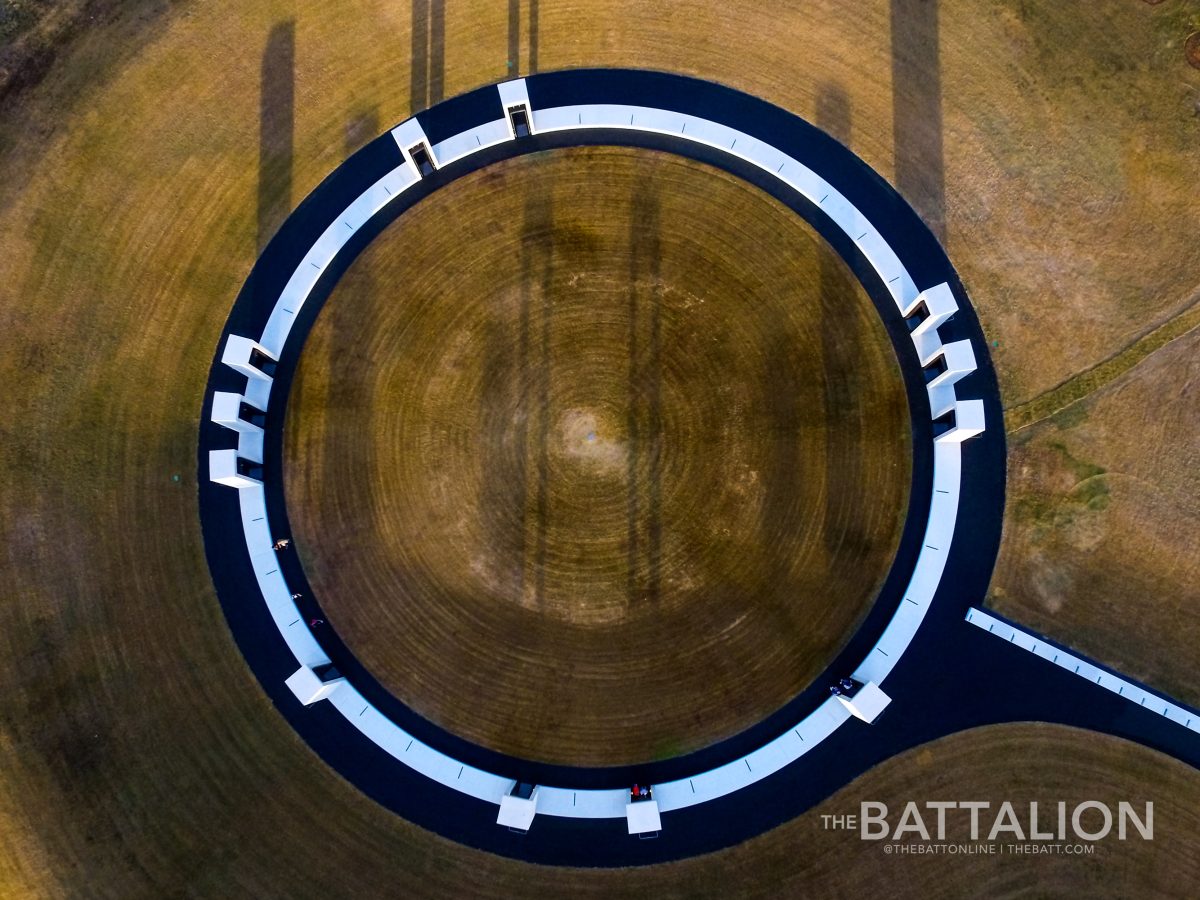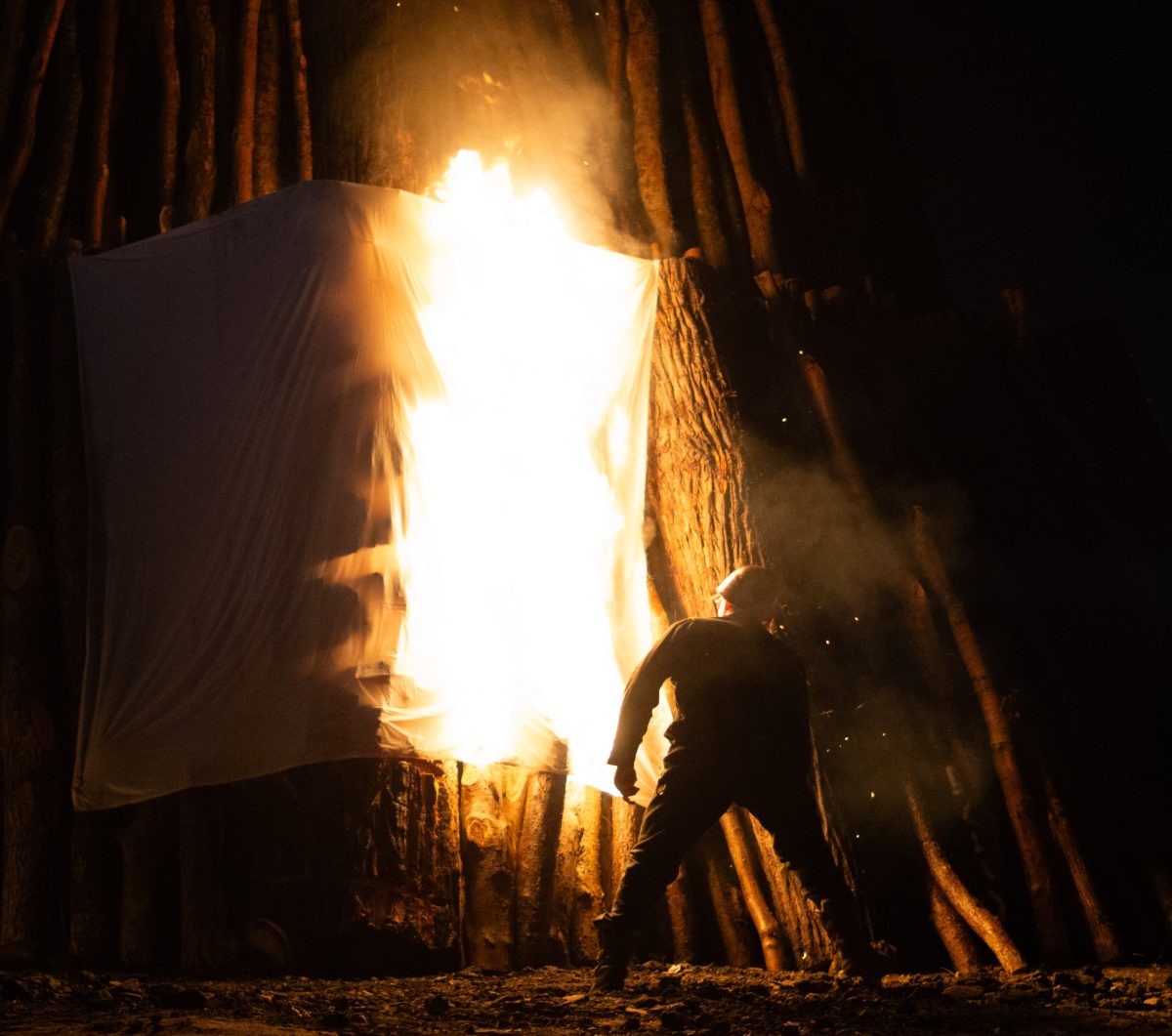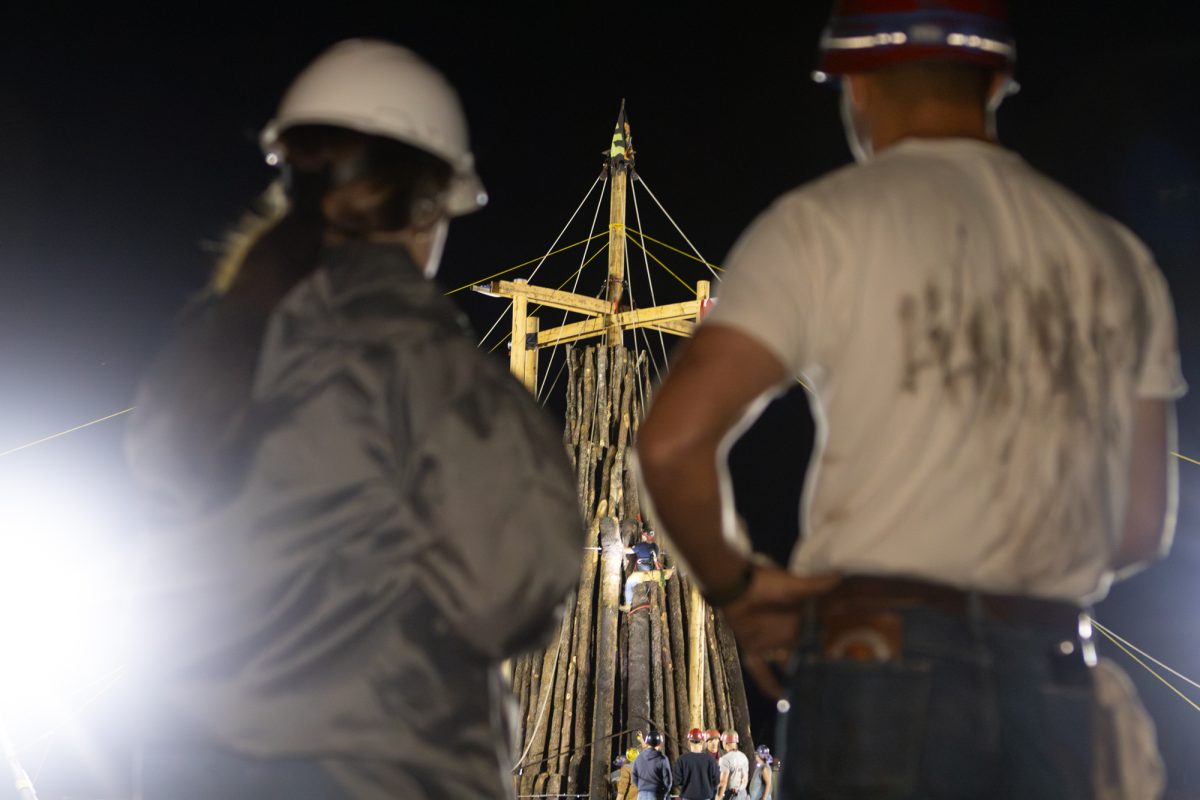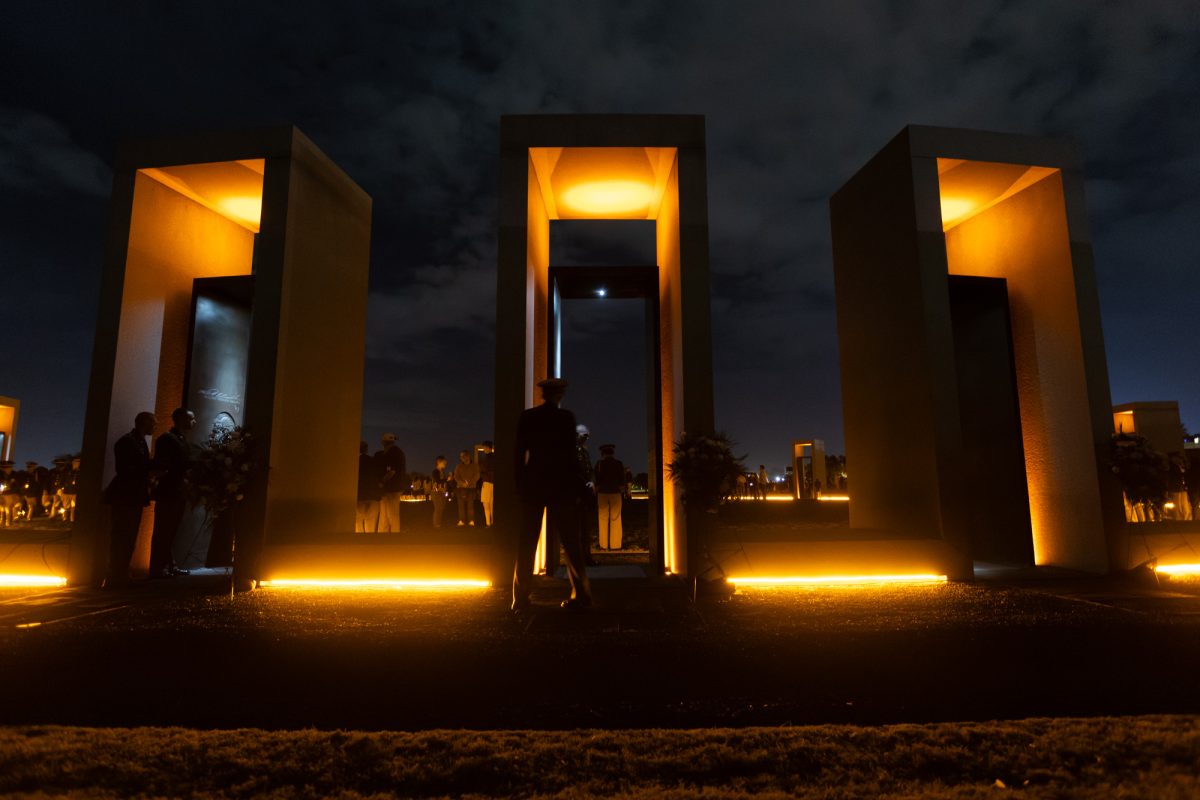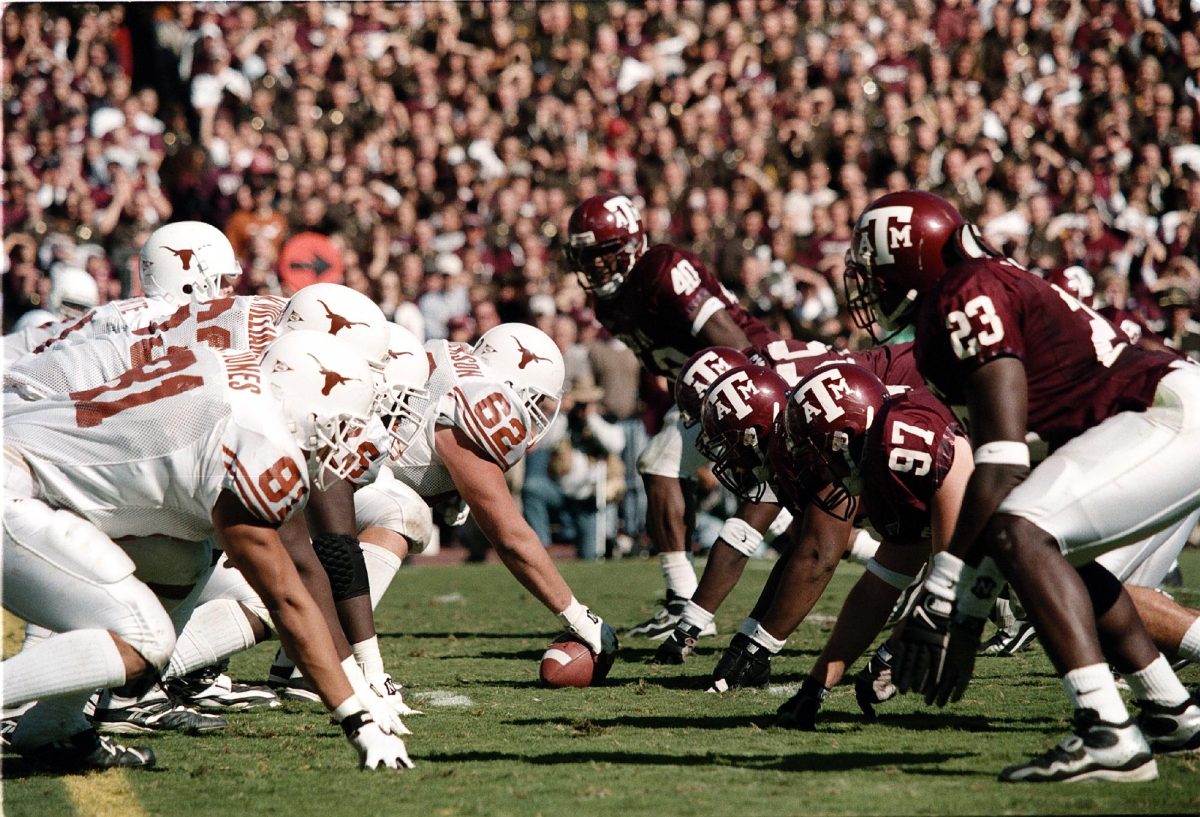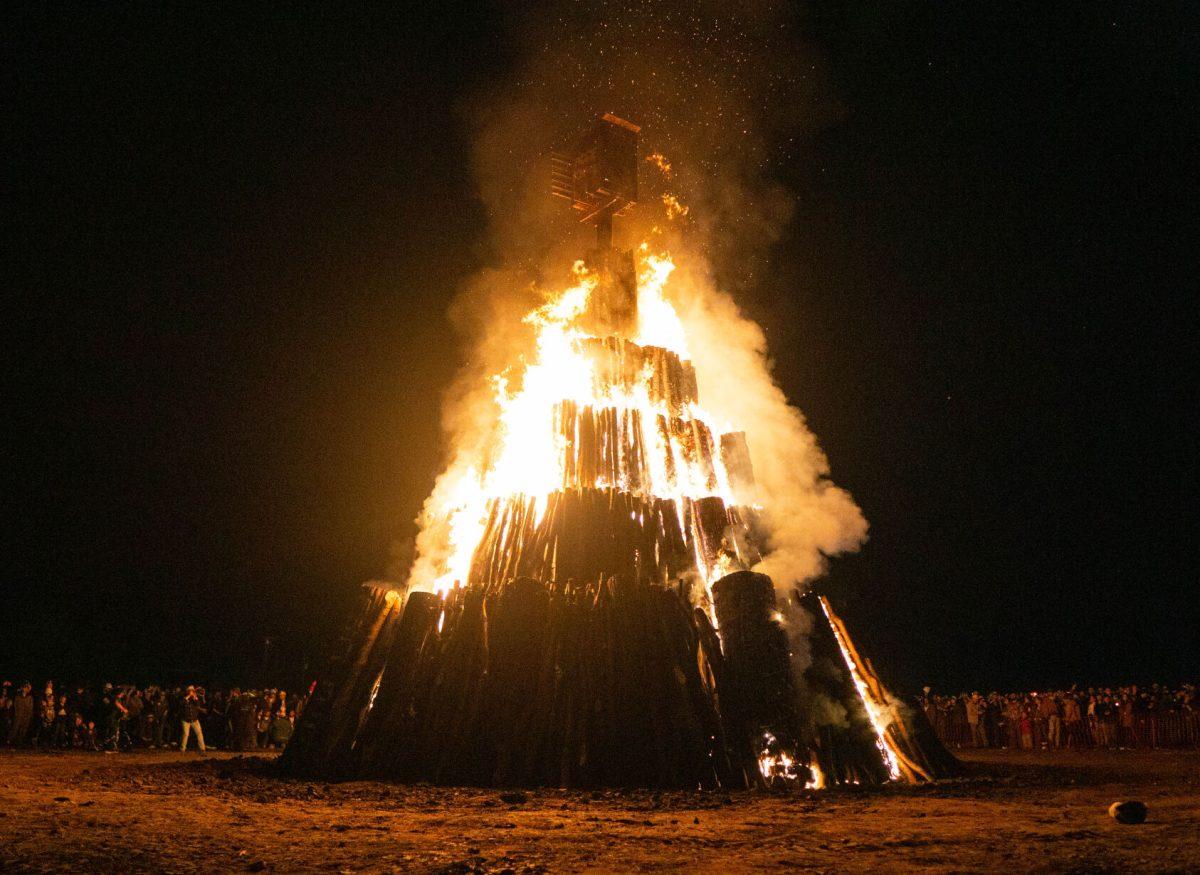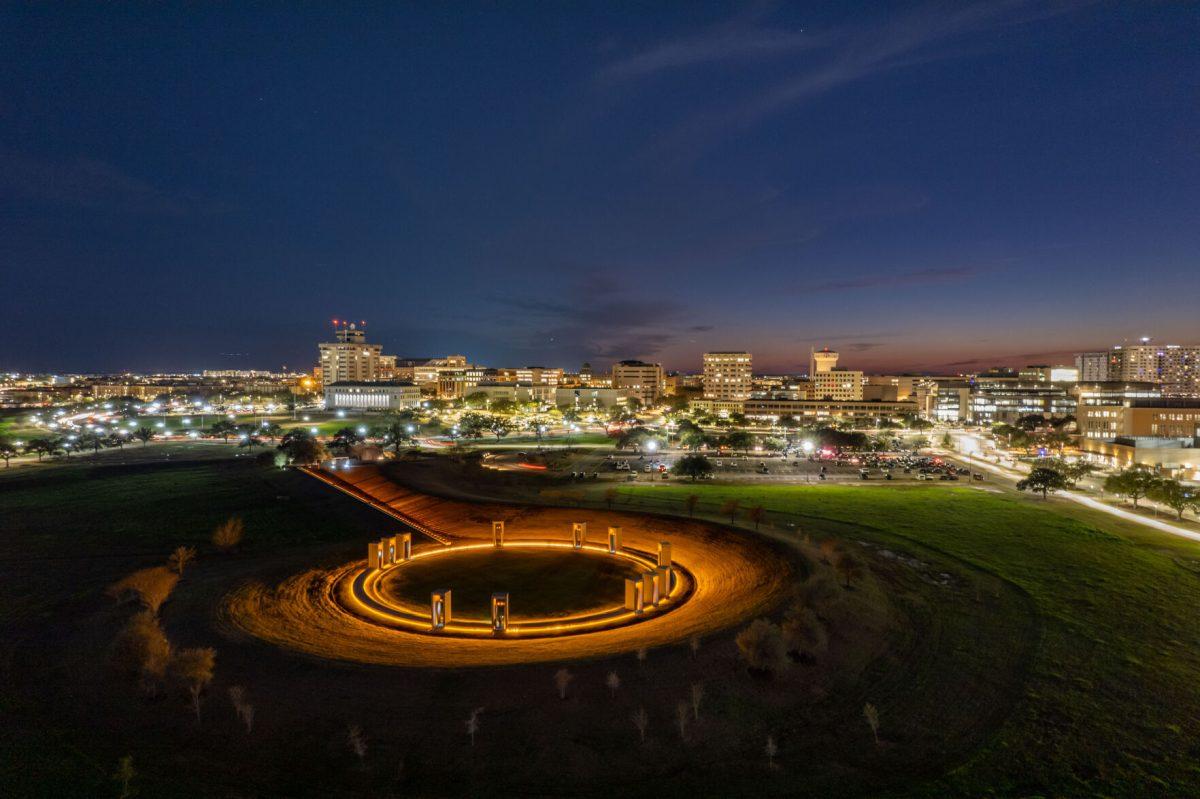Texas A&M changed forever on Nov. 18, 1999, at 2:42 a.m., when the 59-foot-tall Bonfire Stack collapsed. Twelve Aggies died and 27 were injured. Today, on that same ground, there stands a memorial honoring those who lost their lives upholding a storied A&M tradition.
The history
With the rivalry game against the University of Texas approaching, students in 1907 laid the groundwork for a new tradition that would come to be known as Aggie Bonfire. Bored with exam preparations and anxiety, the students set a 12-foot-high pile of trash on fire in anticipation of the matchup with the Longhorns, according to a 1979 Battalion article.
In 1909, students came together to hold an official on-campus Bonfire the night before the UT game, said Dion McInnis, Class of 2003 and current advisor to the upper leadership of Student Bonfire. The student body, then made up of only men in the Corps of Cadets, worked together to construct the Bonfire. It was built annually on the Simpson Drill Field across from the Memorial Student Center until 1955 when it was moved to Duncan Field near the Corps dorms. In 1992, Bonfire moved to the Polo Fields, where the Bonfire Memorial stands today. The Corps became voluntary in 1965, which led to the participation of non-reg students in the building of Bonfire and the creation of roles for each class year.
According to a 1968 Battalion article, the Bonfire was considered to belong to the freshman class that built it, as they furnished most of the manpower, and the upperclassmen oversaw cutting, trucking and stacking.
“Bonfire was peak Aggie-ness,” McInnis said. “It was essential and fundamental and beautiful. The motivation and the passion of Aggie students outgrew the structure, so the structure grew bigger and bigger and bigger.”
In 1963, women were admitted into the university on a limited basis and began helping Bonfire preparations. According to a 1980 Battalion article, the actual date that women began to help is unknown, but in the mid-1960s, women provided refreshments for students taking part in the cut and stack. In 1979, women were officially allowed to help build the bonfire. However, some preferred to continue in their previous role, said Ann Goodman, who previously served as Women’s Bonfire Committee Advisor.
“I worked with the women who helped support the red pots, and the efforts to keep people hydrated and fed during cut and stack,” Goodman said. “The ‘cookie crew’ was a number of women and students that would help out by sponsoring those participating in the cut by making cookies and decorating pots. It was very much a community-building activity.”
Safety and security were a top priority for those involved in Bonfire, including the faculty and staff, Goodman said. For years, the Bonfire stack was heavily guarded to avoid early ignition. It was commonplace for students walking around campus at odd hours to be asked to present their student ID.
Students taking part in Bonfire were required to take mandatory safety classes to learn ax holding techniques and other skills needed to make the first cut, Goodman said. First-time cutters had to wrap pieces of white medical tape around their thighs, known as ‘virgin stripes,’ to indicate that they were inexperienced.
“Despite the fact that we were probably not as thorough as we obviously needed to be in regards to safety, there were safety classes,” Goodman said. “There was an organized and regimented way of training people on how to use their equipment.”
However, there were student and faculty groups opposed to the construction of Bonfire citing harmful effects of the chemicals used to ignite the structure and the needless cutting of lumber as issues. There was also fear that the fire would spread to nearby locations. This issue was taken to the Student Senate in 1970, but resulted in a victory for the beloved tradition, according to a 1979 Battalion article.
With Bonfire being a university-wide celebration, it was designated as a school holiday up until 1973. The administration allowed students to prepare to build the massive structure in time for the Thanksgiving game against UT. However, administrators began to realize that students used this time off to either catch up on sleep or take an extended weekend vacation instead of devoting time to Bonfire. Soon after, the university retracted the holiday.
The Bonfire tradition signified not only the intense desire for Aggies to beat UT but the chance to bond with their fellow Aggies. It was this comradery that the students looked forward to. Each year, the band sophomores crowned the completed Bonfire with a 7-foot-tall outhouse called the “t.u. tearoom” or “t.u. frat house” and adorned it with an Austin highway sign, hoping to “watch t.u. burn” in the upcoming Thanksgiving match. The first cut began in October, and most of November was spent stacking. In 1946, the first center pole was created to allow the stack to increase in height and stability. John Comstock, a survivor of the 1999 collapse, said the cutting of the wood was hard labor and not everyone’s cup of tea. But the committed team members created a close bond and enjoyed the camradery.
“Any student could go out there and work on it,” Comstock said. “It just wasn’t for everybody. We used to say back then that 5,000 people build it and 70,000 watch it burn.”
The Collapse
Nov. 18, 1999, began like every other day for the roughly 58 people building the fourth tier of the Bonfire stack. Students from FHK, Moses and Aston Halls, Corps outfits D-2, K-2, C-2 and Squadrons 16 and 17 began their shifts at 12 a.m. Among those starting their Bonfire shifts was Comstock, who was a freshman at the time.
“It was like any other Stack that we had gone out to before,” Comstock said. “There was some music playing in the background, and it was a little chilly out.”
Almost 3 hours later, the 90-year-old campus tradition turned to tragedy at 2:42 a.m. when the 59-foot stack of logs collapsed, killing 12 and leaving 27 injured.
JP Beato, class of 2003 and then-photographer for The Battalion, said that after working a volleyball game that night, he went out with friends. When returning to his car in the parking garage, he heard a loud crack in the distance and knew something big had happened. With his camera equipment in hand, Beato rushed to the site, capturing photos of the tragedy minutes after.
“We heard it,” Beato said. “We heard it fall. We heard that crack. And that was the only thing going on at that time, 24-hour push. So we heard it and we immediately knew it was that.”
The first 9-1-1 call came in at 2:43 a.m., the same time Goodman received a message to her pager that the Bonfire Stack had collapsed.
“As a member of the critical incident response team, we responded to a number of smaller incidents before that involved minor accidents,” Goodman said. “After the collapse, my role then was to help with the triaging of who had been involved in the collapse, and finding out all of the students who were there and who were missing.”
People at the site reported hearing a loud pop seconds before the collapse, and Comstock said those working on the stack felt the logs shift as it fell in a southeasterly direction toward New Main Drive.
“It swayed enough to throw me off balance, and by the time I regained my balance, [the stack] was already starting to tip and go at that point,” Comstock said. “I just had to grab onto the logs in front of me. It pretty much fell at the speed anything will fall over at. I was maybe knocked out for a few seconds when I hit the ground, but when I opened my eyes, I got a face full of dirt and realized I was trapped.”
Comstock would lie trapped within the 5,000-log stack for seven hours with his legs, arms and head wedged between the fallen timber.
“A log had turned sideways and was at my waist, and I couldn’t feel my legs, so I couldn’t tell if was paralyzed,” Comstock said. “My right arm was completely wedged in between two logs because that’s where I grabbed to hang on to it. There was a log on my head as well so I couldn’t really talk to anybody in the beginning.”
While waiting to be rescued from the stack, Comstock said he remembers talking to one of the first responders, College Station firefighter Darrin Allen.
“I was one of the first ones to find [Comstock] and I laid on the ground with him most of the morning while he was trapped,” Allen said. “He gave me his mother’s telephone number, so that I could call and let her know he was stuck in the collapse and that he was alive.
During the rescue effort, it was determined that the only safe way to get Comstock and others out was to remove the logs by hand, one at a time, so as not to trigger further collapses that could harm rescue crews and those still trapped insite. Many students, including members of the Texas A&M football team and the Corps of Cadets, helped disassemble the fallen stack.
“It was important that these logs be removed by people versus machines because they could gently lift these things off,” Goodman said. “It was all essentially like a game of pick-up sticks. They would pick up one and it would move many others, and early on nobody was sure if the people beneath the logs were alive.”
The body of the last known fatality was removed from the stack at 12:55 a.m. on Nov. 19. Eleven of the people killed in the collapse were students and one was a graduate of the university. Five of the students were freshmen, five were sophomores and one of the deceased was a senior. Two of them were females and ten were males.
Almost 24 hours after the collapse, the emergency operations center was deactivated at 2:20 a.m. after all victims were recovered and every log was moved. According to a report from the U.S. Fire Administration, approximately 3,200 people from at least 50 different agencies were involved in the recovery.
Twenty years later, Aggies remember:
Miranda Denise Adams
Christopher D. Breen
Michael Stephen Ebanks
Jeremy Richard Frampton
Jamie Lynn Hand
Christopher Lee Heard
Timothy Doran Kerlee Jr.
Lucas John Kimmel
Bryan A. McClain
Chad A. Powell
Jerry Don Self
Nathan Scott West
Hallowed ground
November 14, 2019
Photo by Photo by Robert Castro
The Bonfire Memorial is dedicated to those who died in the 1999 Aggie Bonfire Collapse. It stands on the ground where the Bonfire Stack was constructed that year.
0
Donate to The Battalion
Your donation will support the student journalists of Texas A&M University - College Station. Your contribution will allow us to purchase equipment and cover our annual website hosting costs.



